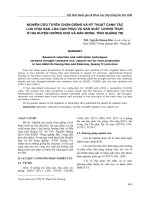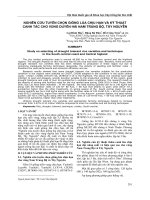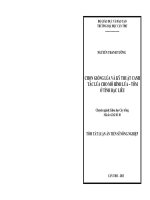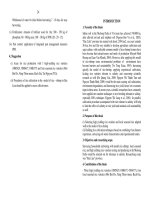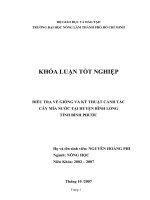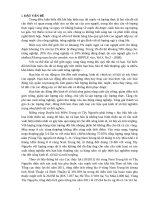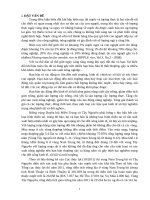tóm tắt luận án chọn giống lúa và kỹ thuật canh tác lúa cho mô hình lúa - tôm ở tỉnh bạc liêu (tiếng anh)
Bạn đang xem bản rút gọn của tài liệu. Xem và tải ngay bản đầy đủ của tài liệu tại đây (220.33 KB, 12 trang )
24
Withdrawal of water for dried before harvesting 7 - 10 days for easy
harvesting.
(v) Fertilization: Amount of fertilizer used for 1ha: 300 - 350 kg of
phosphate; 60 - 100 kg urea; 100 - 130 kg of NPK (20 - 20 - 15);
(vi) Pest control: application of integrated pest management measures
IPM.
4.2 Suggestion
(i) Areas for rice production with 3 high-yielding rice varieties
(OM5629, OM6677, OM6377) and four seasonal rice varieties (Mot
Bui Do, Nang Thom muon, Rach Gia, Tai Nguyen (TG)).
(ii) Procedures of rice cultivation in the model of rice - shrimp in Bac
Lieu should be applied to assess effectiveness.
INTRODUCTION
1. Necessity of the thesis
Saline soil in the Mekong Delta of Viet nam has achieved 740.000 ha,
after alluvial soil and acid sulphate soil (Nguyen Bao Ve et al., 2005).
“Bac Liêu” province has natural soil about 2,594 km2, sea coast extends
56 km, low and flat very suitable to develop agriculture cultivation and
aqua-culture, with realizable common model of rice-shrimp farmers have
been become their attractiveness and mode of production (Huynh Minh
Hoang and Lam Van Khanh, 2004). However, after applying this model
of rice-shrimp some environmental problems of environment have
become barriers and sustainability (Vo Tong Xuan, 1995). Increasing
quickly the model of rice-shrimp, applying experienced cultivation,
lacking rice varieties tolerant to salinity and concerning scientific
research as well (Ho Quang Cua, 2009; Nguyen Thi Thanh Tam and
Nguyen Thanh Binh, 2009) would be the main causing soil salinization,
environment degradation, and decreasing rice yield, hence low economic
input in these areas. In recent years, scientific researchers have commonly
been applied new modern techniques to rice breeding tolerant to salinity,
especially DNA technique (Nguyen Thi Lang et al., 2001). In parallel,
cultivation procedure accompanied with rice tolerant to salinity will help
to limit the effect of salinity on rice yield and maintain soil sustainability
as well.
2. Purposes of this thesis
(i) Selecting high yielding rice varieties and local seasonal rice adapted
well to the model of rice-shrimp
(ii) Building rice cultivation techniques based on combining from farmers
experience, surveying soil-water characteristics and experimental results.
3. Objectives and researching scope.
Surveying households cultivating with model rice-shrimp; local seasonal
rice; and high yielding rice varieties testing and producing in the Mekong
Delta would be selected out for tolerance to salinity. Researching scope
was “Bac Lieu” province.
4. Contributions of the thesis
- Three high yielding rice varieties (OM5629, OM6677, OM6377), four
local seasonal rice varieties (Mot Bui Đo, Nang Thom muon, Rach Gia,
2
Tai Nguyen (TG)) could be well tolerant to salinity, long grain, average
amylose contents, total protein contents were above 9% .
- Built a cultivation procedure for the model of rice-shrimp in the Bac
Lieu province
- Characters of water and soils in the model of rice-shrimp affected on
rice cultivation.
- Effect of water management on saline soil after raising shrimp; type and
dose of calcium application to rice growth and yield.
5. Outline of the thesis
The thesis were 155 pages including 4 chapters with 31 tables, 36 figures
and 7 appendix, 203 references were referred.
CHAPTER 1
OVERVIEW DOCUMENTS
1.1 Effects of salinity on rice
Salinity causes several symtoms on rice such as leaves appeared white at
the top due to (saline soil); brown leaves and died (sodic soil); growth
delayed, weak root growth , rolled leaves, sterile grain, low harvest index,
low yield. As for rice, characteristic of tolererance to salinity is a complex
physiological process, changed according to different growth steps (
Akbar et al., 1972).
1.2 Breeding rice for tolerance to salinity
1.2.1 Research on inheritance to saline tolerance
Bohnert et al.(1996), already suggested a strategy to breed rice tolerant to
salinity, in which protein should be stable; proline with function to
minimize osmotic stress. As for tolerance to salinity, genes control
transport kalium, K
+
/ Na
+
high played an important role to saline
tolerance (Rubio et al., 1995). Rice tolerant to salinity often had the ratio
K
+
/Na
+
>1while sensitive one at shoot and root had the ratio K
+
/Na
+
<1.
Water influx, water channel control under stress conditions were signals
of growth regulator (Bohnert et al., 1996). Protein often appeared at seed
mature stage: LEA and dehydrin, this protein was believed that an
important element in resistance to stress from saline and drought (Xu et
al., 1996).
1.2.2 Some results on rice breeding for saline tolerance
1.2.2.1 World achievements
Plant breeding tolerant to salinity should be optimal and less cost (Ashraf
and Foolad, 2007), Ponnamperuma (1984), Tolerance to salinity was a
23
* On the basis of rice –shrimp cultivation procedures, changes in soil and
water characteristics in the model of rice - shrimp in Bac Lieu province,
and experimental results had made, procedures of rice cultivation in the
model of rice- shrimp were synthesized used as a procedure for rice
cultivation in the model of rice-shrimp:
(i) Seasonal crop: Annual seasonal cultivating of a crop from August to
December. Before rice crop beginning, one should spend 15 - 30
days for soil preparation in order to improve soil in the pond.
(ii) Preparing land: The end of shrimp crop, use rain water or canals
to keep on the paddy field from 10 to 20 cm. When rain arriving,
one should drain water to desaline from 9 - 20 times in 15 - 20
days, rake and land soaking around 7 - 10 days to wash more salty
soil before sowing or transplanting. As for lands covered with 10
cm of silt sediment annually plowing is not required, just clean up
the weeds before transplanting from 5 - 7 days. During the land
preparation, apply fertilizer with type of calcium CaSO
4
(gypsum)
with a dose of about 550 kgha
-1
or calcium type of CaO (calcined
limestone) at a dose of 450 kgha
-1
to help improve rice ability to
saline tolerance, improve productivity and avoid soil salinization
after their rice – shrimp cultivation.
(iii) sowing: Sowing rice seeds in May, June and transplanted in late June
or early July with l ¬ nursing from 50 - 60 kg to 1,000 m2 for
transplanting one hectare; or direct sowing 100 - 120 kg / ha for high
yielding rice;, or from 40 - 60 kg / ha for seasonal rice;
(iv)Water management: Avoid leakage of water or saline water intrusion
during rice cultivation. Before sowing one should drain water, small
furrow dried up. When the rice grows from 5 - 7 days, submerge
water according to the height of rice plant, kept water at 10 - 20 cm.
If there have big rains, continue to drain water to wash salinity and
keep this water level during the growth and development of rice.
22
Table 3.31 Amount of fertilizer used per hectares for high yielding
rice
Time
(day after sowing)
Super
phosphate
(kg)
Urea
(kg)
NPK (20-20-15)
(kg)
Basal fertilizing
300 - 350
-
-
5 – 7
-
30 – 50
-
20 – 25
-
30 – 50
50 - 65
40 – 45
-
-
50 - 65
- Pest control: Application of integrated pest management (IPM) as
follows: use of resistant varieties, well soil preparation, reasonable
season, appropriate sowing or transplanting density, fertilizing application
of balanced NPK to reduce to a minimum the harmful effects from
objects on rice pest. Spraying of pests and diseases on the principle of
four rights: the right chemical, right time, right quantity and the right
way.
CHAPTER 4
CONCLUSIONS AND RECOMMENDATIONS
4.1 Conclusion
* Through research on selection for the model of rice-shrimp in Bac Lieu
province, some results were achievements as follows:
(i) Three high-yielding rice varieties with good saline tolerance, long
grain , low amylose was low or average, protein content > 9%
were: OM5629, OM6677, OM6377 and
(ii) Four seasonal rice varieties with good saline tolerance, long grain,
(6.6 - 7, 5mm), medium amylose content and the protein content >
9%, such as Nang Thom muon, Tai Nguyen (TG), Mot Bui Do,
Rach Gia.
3
component of evaluation and genetic uses, they suggested 8 steps as
follows:
(1) screening should clearly range from 8 to 10 dSm
-1
at 25
o
C.
Percentage of leaf death is an estimated value measuring damage
due to salinity.
(2) Receiving genetic source tolerant to salinity.
(3) Combining tolerant to salinity with other good agronomic
characteristics.
(4) Testing rice varieties tolerant to salinity.
(5) Evaluating in paddy fields and selecting out varieties/lines able to
tolerant to salinity having good characterisitcs such as resistance
to pests, high yield, good quality etc.
(6) Evaluating in International level in many countries.
(7) Carrying out experiments for yield under controlled fields.
(8) Testing on farmer paddy fields.
1.2.2.2 Some achievements in Viet Nam
* Select on traditional seasonal rice: From 1992 to 1995, Southern
Science-Agriculture Institute selected 88 seasonal varieties, 100 high
yielding rice, in which pokkali was used as control for tolerance to
salinity; PTB 33 as a resistant source of brown plant hopper.
Bong et al.,(1996), was already carried out with 15 rice varieties, results
showed that:
(i) Rice seed germination in saline solution 1.5% (24,4 dSm
-1
),
OM1630-50 germinated at maximum rate of 81%.
(ii) Saline tolerance at different concentrations of 4,8,12,16 dSm
-1
,
results showed that all of rice could not survive at 16 dSm
-1
. At
12 dSm
-1
, pokkali and “ Than nong do” were tolerant to high
salinity.
At Cantho University also tested seasonal rice, results also showed that at
seedling stage some varieties could tolerate at 10 dSm
-1
such as “Nang Co
do”, “Than Nong do”, ”Soc Nau”, “ Ba Xuyen”, “ Nep Ruoi moc”.
* Select with high yielding varieties tolerant to salinity
Southern Science Agriculture Institute researched on ability to saline
tolerance of several rice varieties in “Bac Lieu” province and “Ca Mau”,
results showed that Mashuri 5, Khao dawk Mali and OM723-11E gave
high yield and good saline tolerance (Phan Hong Thai et al., 1997). Pham
Thi Phan (1999) showed that MTL119 variety could adapt well in the
model of rice-shrimp- sensitive saline soil along coastal areas of Soc
Trang, Bac Lieu. Also, in 1998 she showed MTL384, MTL466, MTL480,
MTL521, MTL547 could tolerate to acid sulphate soil and saline
4
conditions. Ngo Dinh Thuc (2006) researched on 127 producing rice
varieties, he screened them at EC=30 dSm
-1
, seedling stage at 12 dSm
-1
and observed yield, adaptibility to paddy fields sensitive to acid sulphate
and saline soils; results showed that VD20, ST3, OM3536, Klong Kluang,
ST2 could tolerate well; and OM2395, DS2001 could tolerate to light acid
sulphate and saline soils
* Common rice varieties in the model of rice –shrimp
Nguyen Ngoc De et al. (2003) selected rice adapted to model of rice-
shrimp in “Soc Trang” (My Xuyen district), Bac Lieu (Gia Rai), Mekong
Delta of Viet Nam from 1997 to 1998. They showed that MTL119 could
tolerate well to those conditions. Some other varieties could adapt well to
abnormal rainfall areas such as “ Mot Bui Do”, AS996, OM4498,
OM2517 (Pham van Du, 2009; Phan Minh Quang, 2009).
1.3 Applying technique for selection with saline solution at 6‰
Screening saline tolerance at seedling stage should be done with 6 stages
(Aslam et al., 1993) as follows:
(i) Choose filled grains with well viability, none dormancy, no
disease
(ii) Treatment seeds with HCl 0.1% during 15 minutes.
(iii)Clean with distilled water at least 3 times.
(iv) Put 20 seeds per petri dish having filter paper.
(v) Pour 6 ‰ NaCl solution to petri dish, and distilled water used as
control, then incubate at 28
0
C, and
(vi) Use Pokkali as satandard tolerant to saline and IR28 or IR29 as
sensitive to salinity.
1.4 Apply DNA electrophoresis (microsattelite)
Nguyen Thi Lang et al.(2001) showed that this technique could help rice
breeders to get high successfulness in a short time. The author used with a
pair of primer 223 as follows: forward primer with nuclotide sequence
“GAGTGAGCTTGGGCTGAAAC” and reward primer
“GAAGGCAAGTCTTGGCACTG”, standard variety tolerant to salinity
used was “Doc Phung”, and sensitive one was IR28.
21
- Preparing land: (1) The end of shrimp crop, use rain water or canals
to keep on the paddy field from 10 to 20 cm. Before rice crop beginning,
one should spend 15 - 30 days for soil preparation in order to improve soil
in the pond. When rain arriving, one should drain water to desaline from
9 - 20 times in 15 - 20 days, rake and land soaking around 7 - 10 days to
wash more salty soil before sowing or transplanting. As for lands covered
with 10 cm of silt sediment annually plowing is not required, just clean up
the weeds before transplanting from 5 - 7 days; (2) During the land
preparation, apply fertilizer with type of calcium CaSO4 (gypsum) with a
dose of about 550 kg / ha or calcium type of CaO (calcined limestone) at
a dose of 450 kg / ha to help improve rice ability to saline tolerance,
improve productivity and avoid soil salinization after their rice – shrimp
cultivation.
- Select rice varieties and cultivation techniques: (i) Select rice varieties
with ability to saline tolerance: Use seasonal rice such as “Mot Bui do”,
Rach Gia, Tai Nguyen (TG) or high yielding rice OM6677, OM5629; (ii)
sowing: Before sowing, drain water in the paddy field for drying fields, in
the sunny days, one should replace frequently in order to decrease
temperature and limitation of salinity damage to rice; (iii) Rice Quantity:
100 - 120 kg of rice varieties (high yielding rice) sowing per 1ha, from 40
- 60 kg of rice seeds (seasonal rice) per ha; Sowing seeds in May, June
and transplant in late June or early in July, seed quantity from 50 - 60 kg
used for sowing for 1000 m
2
to transplant one hectare; (iv) Water
managing: Avoid leakage of water or saline water intrusion during rice
cultivation. Before sowing one should drain water, small furrow dried up.
When the rice grows from 5 - 7 days, submerge water according to the
height of rice plant, kept water at 10 - 20 cm. If there have big rains,
continue to drain water to wash salinity and keep this water level during
the growth and development of rice. Withdrawal of water for dried before
harvesting 7 - 10 days for easy harvesting.
- Fertilizer: Fertilizing for rice are presented in Table 3.31
20
Non-application
4,52b
CaSO
4
5,49a
CaO
5,38a
Ca(NO
3
)
2
4,74b
F
**
CV (%)
7,43
Level of application (B)
1
5,28a
2
4,93b
3
4,88b
F
**
CV (%)
7,43
In a column, means with the same letters do not differ significantly at the level 1% by
DMRT
3.3.8 Composing techniques of rice cultivation in the model of rice-
shrimp
On the basis of rice –shrimp cultivation procedures, changes in soil and
water characteristics in the model of rice - shrimp in Bac Lieu province,
and experimental results had made, procedures of rice cultivation in the
model of rice- shrimp were synthesized as folows:
3.3.8.1 Paddy field preparation
Land used for rice – shrimp cultivation, design channels and ponds from
20 - 25% of the total land area. Ditch should be around 2 - 3 m, depth 1 -
1.2 m. Dike ranging from 2 - 2.5 m; higher than the highest tide level of
0.5 - 0.6 m, to be sure that flooding in the fields from 0.6 to 0.8 m. The
side channel from 1 to 2 m wide and ensure the submerged level from 0.7
to 0.8 m, downward to the direction of drainage. Each pond should be 1 -
2 rains should be built.
3.3.8.2 Rice cultivation techniques
- Seasonal: Seasonal cultivating of a crop from August to December per
year
5
CHAPTER 2
THE CONTENT, MATERIALS AND METHODS
2.1 Content and method: 3 content was done
2.11 Investigate household characteristics and economic
performance: Survey randomly rice farmer – shrimp, votes has been
prepared in advance were used in four districts: Hong Dan, Phuoc Long,
Rai and Vinh Loi, in each district chosen randomly 90 farmers for
investigation, total 360 questionnaire votes.
2.1.2 Select high yielding varieties tolerant to salinity (17 varieties)
and seasonal rice varieties (56 varieties):
(i) test salt tolerance of 17 high-yielding rice varieties with salt
concentration at 6 ‰;
(ii) Screen varieties tolerant to salinity by Yoshida nutritional solution
(IRRI, 1997) with added salt at 6‰ NaCl;
(iii) Evaluation of growth and yielding;
(iv) Assessing the quality of rice, and
(v) Using DNA electrophoresis method.
2.1.3 Rice cultivation technique in the model of rice - shrimp:
(i) Survey cultivation technique on the model of rice - shrimp;
(ii) Survey shrimp cultivation technique;
(iii) Estimate water characteristics during experiment;
(iv) Estimate some chemical properties of soil;
(v) Manage water on saline soils after the shrimp season affected to
rice yield;
(vi) Affect types of Ca
2+
fertilizer on the production of proline in
rice;
(vii) Affect types and doses of Ca
2 +
on the growth and yield, and
(viii) Build a general model of cultivation techniques for the model of
rice-shrimp.
2.2 Materials
Varieties/lines of rice: 56 Group season rice varieties in the Department
of Genetics Faculty of Agriculture and shud, CTU, 17 short-term high-
yielding rice varieties and 01 varieties of salt tolerance standard, 01
standard varieties salinity of Rice Institute Delta, 01 standard varieties
salinity of the International Rice Research Institute (IRRI); Chemicals:
NaOH, ethanol, Coomassie brilliant blue, mercapthoe-thanol, acrylamide,
bis-crylamide, ammonium persulfat, BSA protein standard
6
2.3 Methods
Agronomic traits, yield components and the quality of rice:
Methods of measurement (hand, tools specialized for each trait).
Check the saline tolerance by DNA electrophoresis methods
(microsatellite) with forward primer 223 with sequence nucleotide
GAGTGAGCTTGGGCTGAAAC and reverse primer 223 with sequence
nucleotide GAAGGCAAGTCTTGGCACTG.
Grouping of saline tolerance by DNA electrophoresis methods
demonstrated by the appearance of DNA electrophoresis band of the same
DNA standard variety control.
Analysis: amylose by IRRI methods (1978), total protein by the Lowry
method (1951); samples of soil and water by the method of chemical
analysis indicators (Clesceri et al., 1998)
2.4 Statistical Treatment
The data were processed using SPSS statistical software. Analysis of
variance (ANOVA) to detect differences among treatments, compared to
the average values by Duncan range method or LSD.
CHAPTER 3
RESULTS AND DISCUSSION
3.1 Household characteristics and economic efficiency of the model of
rice - shrimp in Bac Lieu
3.2 Select rice varieties tolerant to salinity for cultivation in the model
of rice- shrimp in Bac Lieu
3.2.1 Select high-yielding rice varieties tolerant to salinity for the
model of rice-shrimp
3.2.1.1 Test saline tolerant ability of 17 high yielding varieties with
6‰ NaCl
Treatment concentration of 6 ‰NaCl showed all of 17 promising high
yielding varieties were germinated; however, rate of germination were
distinct depending on varieties (Table 3.6). This result were suitable to
the results of Pearson et al. (1966) conclusion.
19
At the beginning of the rice season due to less rainfall, soil salinity should
not be washed of the EC value before sowing was 13.2 mScm
-1
, this value
could affect on growth rice. However, after rice sowing changes in EC
values decreased gradually, to the period of 30 days after sowing, the soil
EC values of all treatments ranged from 3.35 - 4.35 mScm
-1
and
significantly different at 1%. Treatments applying CaSO
4
had the lowest
EC (3.35 mScm
-1
) compared with no fertilizer treatments Ca
2+
(4.17
mScm
-1
) or applying with CaO (4.35 mScm
-1
). At rice harvesting, EC
water
of all treatments ranged from 2.57 - 2.71 mS cm
-1
and did not differ
significantly. This suggested that, at harvest EC of the treatments were
reduced by washing the saline many times, this result was consistent with
Khattak et al. (2007), Nguyen Huu Kiet et al. (2010).
3.3.7.7 The effect of calcium on rice yield
Salinity caused a significant reduction in rice yield. Yield among
treatments ranged from 4.52 to 5.49 tons ha
-1
was significantly different
(Table 3.30). Application of Ca
2+
in the different levels would give yield
significantly different at the 1% .Results showed that rice yields achieved
5.28 tons ha
-1
at level 1 of applying calcium, higher than level 2 of
applying calcium to 4.93 tons ha
-1
and 3 to 4.88 tons ha
-1
, which was
consistent with the report of Aslam et al.(2000), Khan et al. (2007), Le
Huy Vu (2008). The different types of Ca
2+
also leds to productivity
differences among the treatments at 1%. Rice yield from the type of
CaSO
4
(5.49 ton ha
-1
) and CaO (5.38 tons ha
-1
) was higher than the type
of Ca(NO
3
)
2 (
4.74 ton ha
-1
) or no fertilizer (4.52tons ha
-1
). Application of
CaSO
4
and CaO increased rice yield by 21.6% and 19.1% compared to no
applying of fertilizer calcium, which was also consistent with the report
of Shah et al. (2003).
Table 3.30 Effect of type and level application of calcium on rice yield
Treatment
Practical yield (ton/ha)
Type Calcium (A)
18
number of salt ions in soil colloids, particularly Na
+
ion. Sodium being
removed from the land washed by removing the water several times.
3.3.6.9 Effect of the types of calcium applying to rice yield
Grain yield was significantly affected by salinity 10‰ and statistically
significant difference at the 1% level among treatments (Table 3.27). The
highest yield obtained from control treatment (4.47 g/pot), next was
fertilizer treatments Ca(NO
3
)
2
1.92 g/pot, higher than CaSO
4
fertilizer
treatments (1,55g/pot) and CaO (1.32 g/pot), and the lowest yield of
1.29g/pot in treatments without fertilizer Ca
2+
. Results showed that the
saline irrigation for paddy rice yield was significantly reduced compared
with treatment control (non saline irrigation). The applying Ca
2+
, type
Ca(NO
3
)
2
has maintained a higher yield than the form CaSO
4
và CaO,
particularly higher than dipping saline treatment but non aplying with
calcium (Khattak et al., 2007).
Table 3.27 Effect of type calcium on rice yield
Treatment
Practical yield (g/pot)
Control
4,47a
Saline - 0 Ca
2+
1,29d
Saline - CaSO
4
1,55c
Saline - CaO
1,32cd
Saline - Ca(NO
3
)
2
1,92b
F
**
CV (%)
6,18
In a column, means with the same letters do not differ significantly at the level 1% by DMRT
3.3.7 Effect of the type and dose of calcium fertilizers on the growth
and yield OM6677
3.3.7.1 Change in EC value in the field experiments
7
Table 3.6 Ratio (%) of germination, survival and death after
treament with 6‰ NaCl.
Ratio (%) seedling
development after 8 days
in saline solution
Ord.
Name
Ratio (%)
germinated
after 3 days
in saline
solution
survival
death
1
OM4900
100
90,0
10,0
2
OM5629
100
100
00
3
OM5900
100
95,0
5,0
4
OM5981
100
95,0
5,0
5
OM6055
100
90,0
10,0
6
OM6065
95
75,0
20,0
7
OM6070
100
75,0
25,0
8
OM6073
95
75,0
20,0
9
OM6162
100*
95,0
5,0
10
OM6377
100
100
00
11
OM6677
100
100
00
12
OM6877
100
95,0
5,0
13
OM7345
95
80,0
15,0
14
OMCS2009
100
80,0
20,0
15
HĐ
95
90,0
5,0
16
TP2
100
85,0
15,0
17
VD20
95
85,0
10,0
18
Doc Phung (tolerant control)
100
100
00
19
IR28 (sensitive control
100*
85,0
15,0
20
IR29 (sensitive control
90,0*
70,0
20,0
* low germination, unequal
After 8 days germination checking four rice varieties germinated 100%,
including 4 varieties OM5629, OM6377, OM6677 and standard saline
tolerant rice control was Doc Ph
ụng.
Vo Cong Thanh (2009) used
sensitive standard control IR28 or IR29. From experiment with salinity at
6‰, nine rice varieties germinated 100% after 3 days tested; there were 9
varieties still survived over 90%, they were OM4900, OM5629, OM5900,
OM5981, OM6055, OM6162, OM6377 , OM6677 and OM6877. Those
were testing in the paddy fields, IR28 and IR 29 were used as sensitive
controls.
8
3.2.1.2 Evaluation on yields of nine varieties in saline soils at two
villages in Gia Rai district, Bac Lieu province.
At site 1, we did the experiments at two villige (Phong Tan 1 and 2).
Results showed that OM6677 was the highest yield while in site 2, Phong
thanh, OM5629 was the highest, next was OM 6377 (Table 3.9).
Table 3.9 Practical yields of 9 rice varieties tolerant to salinity at
three sites in Gia Rai district, Bac Lieu province
Yield (ton ha
-1
)
Ord.
Name
Phong Tân 1
Phong Tân 2
Phong Th
ạnh
1
OM4900
3,35bc
3,35bc
4,10c
2
OM5629
4,67a
4,67a
5,80a
3
OM5900
3,35bc
3,35bc
3,62cd
4
OM5981
2,75cd
2,75cd
3,83c
5
OM6055
2,40de
2,40de
2,86de
6
OM6162
3,08bc
3,08bc
3,63cd
7
OM6377
3,44b
3,44b
4,32bc
8
OM6677
4,71a
4,71a
5,00b
9
OM6877
2,97bcd
2,97bcd
3,80c
10
IR28
1,94e
1,94e
2,35e
11
IR29
2,09e
2,09e
2,21e
F
**
**
**
CV(%)
10,65
10,65
12,17
In a column, means with the same letters do not differ significantly at the level 1% by
DMRT.
OM5629 rice yield was 5.8 tons ha
-1
, higher than OM6055, IR28, IR29.
The average yields of each experiment was 3.4 tons ha
-1
. Actually, data
collected in Phong Thanh showed that yields of 11 varieties used in the
experiment were significantly different by statistical analysis (Table 3.9),
the highest was OM5629 5.8 tons ha
-1
, the lowest IR29 (control), 2.21
tons ha
-1
, average yield was 3.77 tons ha
-1
.
In summary, by evaluation on the growths and yields of 9 selected salt-
tolerant rice varieties were 3 varieties OM6377, OM6677 and OM5629;
they were more productive varieties than the remain rice.
3.2.1.3 The quality of the 3 high-yielding rice varieties rice
OM6377, OM6677 and OM5629 salinity
According to Nguyen Thi Tram (2001) rice with average amylose content
was of the good taste. Three varieties had amylose content were average
17
Before applying fertilizer Ca
2+
, EC
water
of the treatments ranged from
0.268 to 0.310 mS cm
-1
and were not significantly different. However, the
EC value of the treatments significantly ranged 0.353 to 2.31 mS cm
-1
after 2 days of applying fertilization Ca
2+
, significantly different at 1%
(Figure 3.32a). The treatments with Ca2
+
had EC
water
higher than the
control treatment, no applying fertilizer Ca
2+
. As for aplying lime
treatments with Ca(NO
3
)
2
EC was the highest at 2.31 mS cm
-1
.
a)
b)
Figure 3.32 Change of EC treatments: a) EC before and after applying
Calcium b) EC at different growth satges
This suggested that the applying Ca
2+
in the soil did happen soil cation
exchange process in the soil colloids. Calcium has replaced the site of a
EC
wate
EC
wate
control
harvest
days
days
days
berore applying
fertilization Ca
2+
berore after
fertilization Ca
2+
control
16
treatments dipped salinity directly. At 65-day , the EC of all treatments
had ranged from 0.93 - 1.08 mScm
-1
and were not significantly different.
Hanson et al. (1999), showed that rice yield reduction of 12% for each
unit of ECe (mScm
-1
) increased, when ECe at root zone average > 3.0
mScm
-1
. With experimental results showed that the EC value (1.78-2.72
mScm
-1
) was less impact on the growth of rice plants. At rice harvest, the
EC value of the treatments ranged from 2.12 - 3.53 dS m
-1
were
significantly different at 1%. As for treatments 2
nd
and 4
th
EC were 2.12
and 2.17 dSm
-1
, respectively, lower than the other treatments. Grattan et
al. (2002), the seasonal average salinity of the field exceeds 1.9 dSm
-1
could reduce rice yields, but the current suggestion that salt could affect
on rice productivity when EC> 3.0 dSm
-1
.
Figure 3.29 Movement of EC
water
through the growth stages of rice
Note:
NT1: continuous salinity dipping 3,5 months
NT2: Keep soil dried 1 month + dip fresh water 1 week
NT3: Keep soil dried 1 month + dip saline water 1 week
NT4: Keep soil dried 2 months + dip fresh water 1 week
NT5: Keep soil dried 6 months + dip fresh water 1 week
NT6: Keep soil dried 6 months + dip saline water 1 week
3.3.6 Effect of the type of calcium fertilizers in saline soil to rice yield
and prolin production on rice OM6677
3.3.6.1 EC of water and land
EC
water
days
days
days
harvest
before soving
days after soving
9
group (Table 3.11), long grain, high protein content (9.12-10.48%). Next,
these three rice varieties continued to analyze by DNA technique.
Table 3.11 The quality of the 3-saline tolerant high-yielding rice
varieties
Ord.
Name
Long grain
(mm)
Amylose
content (%)
Protein
content (%)
1
OM5629
6,9
16.21
10.48
2
OM6377
7,3
21.40
9.90
3
OM6677
7,1
19.79
9.12
3.2.1.4 Check the saline tolerance of 3 three rice varieties
OM6377, OM6677 and OM5629 by DNA technique
Results checked by DNA method (Figure 3.8) showed that all three rice
varieties had the same DNA band as the standard saline tolerance control
(Doc Phung), all of them run faster than than the DNA of the sensitive
IR28 and IR29.
Figure3.8 DNA profile of three saline tolerant rice varieties, run with
primer 223, well 6 , standard tolerant control
IR28
IR29
OM6377
OM6677
OM5629
Doc Phung
Ladder
700bp
800bp
50bp
150bp
200bp
300bp
500bp
600bp
10
3.2.2 Choose seasonal rice varieties for the model of rice-shrimp
3.2.2.1 Screening rice germplasm with Yoshida solution added with salt
(IRRI, 1997) Results of checking saline tolerance of the germplasm,
including 56 seasonal rice showed that after treatment salinity
concentration at 6 ‰ during 14 days sensitive control IR29 died all; 20
varieties were tolerance at level of 3, equivalent to the same standard such
as “Doc Do, Gie Hanh, Lem Bui (TV), Lua Ca Mau, Lua Soi (BT), Mot
Bui do, Nang Thom muon, Tai Nguyen (TG), Rach Gia, Trang Tet, Nep
Ruoi” ; 10 varieties tolerance at level of 5 (average), 17 sensitive
varieties at level of 7, 15 were sensitive at level of 9.
3.2.1.2 Evaluation on the quality of seasonal rice germplasm
* Grain Length: Grain length of the germplasm ranged from 5.5 mm to
7.5 mm, in which long grain (6.6-7.5mm) (Table 3.12) achieved 25
acessions, 44.6% (Nang Thom Cho Dao, Khao dawk Mali…), then
medium grain (5.51mm-6.6mm) achieved 30 acessions, 53%, short grain
(<5.5mm) : 1 acessions, 1.7%.
Table 3.12 Classification of seasonal rice germplasm based on grain
length
TT
Group
Total
Acession Code
Ratio
(%)
1
Shorter
5,5 mm
1
16
1,7
2
Medium
5,51 - 6,6 mm
30
1, 2, 3, 4, 5, 7, 8, 10, 15, 17, 18, 19, 21,
22, 23, 24, 25, 26, 31, 29, 54, 56, 38, 41,
43, 42, 45, 46, 47, 48
53,5
3
Long
6,6-7,5 mm
25
6, 9, 11, 12, 13, 14, 20, 27, 28, 30, 32, 33,
34, 35, 51, 52, 53, 55, 36, 37, 39, 40, 44,
49, 50
44,6
Amylose content: Results from analyzing amylose contents showed that
this trait ranged from 1.16% (Nep Sap) to 31.45% (U17). There were 6
varieties with amylose content, ranged 3 to 19%, average content ranged
from 20-24%, 11 accessions; amylose content were over 25%, achieved
38 accessions, 67.8% (Table 3.14).
15
- Preparing the field before raising shrimp: dredging layers of silt
deposition, the time level of exposure to different fields, the number of
times the pump discharge different fields, the level of different
investment (money, time, cultivation technique etc) to focus on raising
shrimp and fertilize lime in general low. These could cause soil
salinization affecting on rice yield.
- Water technical management of shrimp raising: pump discharge for
many times. It was favorable for shrimp raising; however, this condition
would cause disadvantage to rice cultivation in the model.
- Methods to prepare the paddy field before rice cultivation were still
natural crude, when fail to raise shrimp season, farmers often left the
paddy field empty, this condition would bring soil to salinity and acid
sulphate soil increasing.
- Water management techniques in rice farming: The time numbers of
discharge pumping were very different among farmers, this showed the
limitations of desalination among rice-growing areas.
Changes in pH, Fe total , Al
3 +
of the soil and EC
water
of the water surface
in the paddy field showed high salinity (rice season ranged from 1.08 to
12.48 ‰, and shrimp farming ranged from 8.83 to 34.1 ‰) , the amount
of sodium in the soil solution extract is high in saturated and at the end
shrimp crop ranged from 81-213meq/100g soil, early rice crop ranged
from 64-153meq/100g soil, these conditions brought to prove that salt
washing not absolutely after the shrimp crop could affect to rice
cultivation.
3.3.5 Effect of water management on saline soil after raising shrimp
to yield of OM6677
3.3.5.2 EC movement through the growth stages of rice
The experiment was arranged with six treatments (Figure 3.29), at the
time before sowing, EC
water
of the treatments ranged from 0.426 mScm
-1
to 0.780 mScm
-1
different at 1%. Treatment 4
th
(NT4) with the lowest EC
in 0.426 mScm
-1
. Meanwhile, treatments 1
st
(NT1) and 6
th
(NT6) have the
highest EC, e.g 0.694 and 0.780 mScm
-1
respectively. After desalination
EC values become lower and could grow rice. At 20 day-old rice plants,
the treatments EC ranged from 1.78 - 2.72 mScm
-1
; rice at 40 days, the
EC value of the treatments ranged from 1.28 - 2.22 mScm
-1
; EC values at
the these two stages were statistically different at the 1%. Fresh water
dipped treatments one week prior to salinity dipping had EC lower than
14
3.3.4 Characters of soil chemical properties in rice-shrimp
farming
Cultivation times:
Đ
ợt 1
–When soil preparation ; Đ
ợt 2
–After seed broadcasting or transplanting
30 days; Đ
ợt 3
- Flowering; Đ
ợt 4
– Harvesting; Đ
ợt 5
– Release shrimp; Đ
ợt 6
–Harvest shrimp
Figure 3.27 ECe change at soil layers 0 - 20 cm (a), 20 - 40 cm (b) during
stages of rice-shrimp cultivation in Bac Lieu
Results of soil analysis measurements of EC
e
in soil layer “0-20cm”
showed that Hong Dan, Gia Rai, Vinh Loi, Phuoc Long districts were
significantly different during 6 times to cultivate rice-shrimp (Figure
3.27, a)
Similarly, in the soil layer “20-40 cm” three districts, e.g. Gia Rai, Vinh
Loi, Phuoc Long were significantly different while Hong Dan district was
not different during 6 times to cultivate rice-shrimp (Figure 3.27,b).
According to the salinity level of Ton That Chieu et al. (1991), the ECe
from 2 to 4 dS m
-1
is evaluated as the average salinity and EC> 4 dS m
-1
salinity. All four districts had ECe>4 dS/m-1, so this condition would
cause damage to rice cultivation.
General remarks: Based on our survey data, analysis of soil and water,
rice cultivation after shrimp season would bring to some limitations as
follows:
Đợt 1 Đợt 2 Đợt 3 Đợt 4 Đợt 5 Đợt 6
0
5
10
15
20
25
Đợt 1 Đợt 2 Đợt 3 Đợt 4 Đợt 5 Đợt 6
EC trong đất (mS/cm)
Hồng Dân Phước Long
Giá Rai Vĩnh Lợi
Hong Dan
Cultivation times
Phuoc Long
Vinh Loi
Gia Rai
EC
e
11
Table 3.14. Classification of seasonal rice germplasm based on
amylose content
Ord
Group
total
Acession code
Rate
(%)
1
Sticky (0-2%)
1
55
1,7
2
Low (3-19%)
6
14, 51, 52, 53, 54, 56
10,7
3
Average (20-24%)
11
4, 5, 19, 20, 26, 32, 33, 40, 41, 42, 44
19,6
4
High (>25%)
38
1, 2, 3, 6, 7, 8, 9, 10, 11, 12, 13, 15,
16, 17, 18, 21, 22, 23, 24, 25, 27, 28,
29, 30, 31, 34, 35, 36, 37, 38, 39, 43,
45, 46, 47, 48, 49, 50
67,8
Protein content: Protein contents of the rice seasonal germplasm
ranged from 7.52 to 12.83%, in which “ Nep 4 thang” was the
lowest while the highest was “ Nang Quot Bien” (Table 3.17).
Table 3.17 Classification of seasonal rice germplasm based on
protein content
Ord.
Protein
content
total
Accession code
Rate
(%)
1
7 - <8 %
2
51, 49
3,5
2
8 - <9 %
5
13, 27, 35, 55, 56
8,9
3
9 - <10%
16
3, 8, 12, 15, 18,19, 20, 22, 25, 28, 34, 41, 42,
44, 53, 54
28,5
4
10 - <11%
14
1, 5, 7, 9, 11, 14, 17, 30, 32, 33, 43, 46, 48, 50,
25,0
5
11 - <12%
17
2, 4, 6, 10, 16, 21, 23, 24, 26, 52, 36, 37, 38, 39,
40, 45, 47
30,3
6
12 - <13%
2
29, 31
3,5
3.2.2.3 Check the saline tolerance of 56 seasonal rice accessions
by DNA electrophoresis
Result from DNA method with a saline tolerant indicator primer 223
showed that 1 accession was disappeared (well 6) (Figure 3.10); 4
accessions (Nep Ruoi, Trang Tep, Lem Bui, Lua Ca Mau) had the same
DNA band as the saline tolerant control, Doc Phung (well 2), 6
accessions (Nep La He, Nep 4 Thang, Nep Sap, Nep Ba Gia, Bay Hoa,
Thanh tra) had the same DNA band as the sensitive control, IR28.
12
Ladder Ladder
(1) IR 28, (2 ) Doc Phung, (3) Nep La he, (4) Nep Ruoi, (5) Nep 4 thang, (6) Nep Vo Vang,
(7) Nep Sap, (8) Nep Ba Gia, (9) Trang Tet, (10) Lem Bui (TV), (11) Lua Ca Mau,
(12) Bay Hoa, (13) Thanh Tra
Figure 3.10 DNA profile of 11 seasoanal rice compared to the
sensitve (1) and tolerant control (2)
In conclusion, by DNA electrophoretic analysis we also recorded a
number of individual DNA band in the range between DNA band of the
same Doc Phung and IR28;
In summary, these accessions tested with primer 223 could group into
three : Sensitive, tolerate and medium (Table 3.18).
Table 3.18 Grouping 56 seasonal rice saline tolerant accessions
Ability to saline
tolerance
Total
Accssion code
Rate
(%)
Sensitive
27
3, 4, 5, 7, 8, 10, 11, 12, 14, 23, 27, 28,
31, 34, 36, 37, 38, 39, 44, 45, 46, 49,
50, 51, 52, 53, 55
48,2
Tolerate
21
2, 9, 13, 16, 18, 19, 20, 22, 24, 25, 26,
29, 30, 32, 33, 40, 54, 41, 42, 43, 48
37,5
Medium
8
1, 6, 15, 17, 21, 35, 47, 56
14,2
3.2.2.4 Selection of salt-tolerant seasonal rice varieties
The result of selection on saline tolerant seasonal rice varieties,
evaluation on the quality of 56 varieties of seasonal rice and checking
saline tolerance by DNA method, we chose 4 saline tolerant varieties
with good quality: long grain group (6.6 - 7.5 mm), medium amylose
content and the high protein content including: “Mot Bui Do, Nang Thom
1 2 3 4 5 6 7 8 9 10 11 12 13
13
muon, Rach Gia, Tai nguyen (TG )” were suitable for laying out farming
field experiment.
3.3 Rice cultivation technique for the model of rice- shrimp in Bac
Lieu
3.3.3 Characters of water in the model of rice-shrimp affected on rice
cultivation.
* EC
water
: EC
water
in channels and paddy field in the research areas
changed according to the seasons (Figure 3.20)
Đ
ợt 1
–When soil preparation ; Đ
ợt 2
–After seed broadcasting or transplanting 30 days;
Đ
ợt 3
- Flowering; Đ
ợt 4
– Harvesting; Đ
ợt 5
– Release shrimp; Đ
ợt 6
–Harvest shrimp
Figure 3.20 Change of EC
water
in channel (a), water in paddy field (b)
productive stages in the model of rice-shrimp in Bac Lieu province
The results showed that in seasonal rice cultivation, the salinity of the
water in the rice fields had higher tendency than channel water salinity,
this may be due to high soil salinity in paddy fields, also the ability to
evaporate much water in the paddy fields so it could affect rice yields.
EC
water
in channels and paddy fields of four regions studied was
statistically significant differences in stages of rice- shrimp cultivation.
EC
water
tended to be high in the early rice crop, lower at the middle of rice
crop, then higher at rice harvest upto got maximum at the end of shrimp
season (Figure 3.20).
In general, the EC in each study region is not optimal yet for effective
rice yield (IRRI, 2000).
0
20
40
60
Đợt 1 Đợt 2 Đợt 3 Đợt 4 Đợt 5 Đợt 6
EC nước (mS/cm)
Hồng Dân Phước Long
Giá Rai Vĩnh Lợi
Đợt 1 Đợt 2 Đợt 3 Đợt 4 Đợt 5 Đợt 6
Phuoc Long
Gia Rai
Vinh Loi
Hong Dan
EC
water



